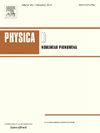The amplitude equation for the space-fractional Swift–Hohenberg equation
IF 2.9
3区 数学
Q1 MATHEMATICS, APPLIED
引用次数: 0
Abstract
Non-local reaction–diffusion partial differential equations (PDEs) involving the fractional Laplacian have arisen in a wide variety of applications. One common tool to analyze the dynamics of classical local PDEs very close to instability is to derive local amplitude/modulation multiscale approximations, which provide local normal forms classifying the onset of a wide variety of pattern-formation phenomena. In this work, we study amplitude equations for the space-fractional Swift–Hohenberg equation. The Swift–Hohenberg equation is a basic model problem motivated by pattern formation in fluid dynamics and has served as one of the main PDEs to develop general techniques to derive amplitude equations. We prove that there exists near the first bifurcation point an approximation by a (real) Ginzburg–Landau equation. Interestingly, this Ginzburg–Landau equation is a local PDE, which provides a rigorous justification of the physical conjecture that suitably localized unstable modes can out-compete superdiffusion and re-localize a PDE near instability. Our main technical contributions are to provide a suitable function space setting for the approximation problem, and to then bound the residual between the original PDE and its amplitude equation, i.e., to rigorously prove a multiscale decomposition between the leading critical modes and the higher-order remainder terms.
空间分数斯威夫特-霍恩伯格方程的振幅方程
涉及分数阶拉普拉斯算子的非局部反应扩散偏微分方程(PDEs)已经得到了广泛的应用。分析非常接近不稳定的经典局部偏微分方程动力学的一个常用工具是推导局部振幅/调制多尺度近似,该近似提供了对各种模式形成现象的开始进行分类的局部正规形式。本文研究了空间分数阶Swift-Hohenberg方程的振幅方程。Swift-Hohenberg方程是流体动力学中以模式形成为动机的一个基本模型问题,是发展一般振幅方程导出技术的主要偏微分方程之一。我们证明了在第一分岔点附近存在一个(实)金兹堡-朗道方程的近似。有趣的是,这个金兹堡-朗道方程是一个局部偏微分方程,它提供了一个物理猜想的严格证明,即适当的局部化的不稳定模式可以胜过超扩散,并在不稳定附近重新局部化偏微分方程。我们的主要技术贡献是为逼近问题提供一个合适的函数空间设置,然后将原始PDE与其振幅方程之间的残差绑定,即严格证明领先关键模态和高阶剩余项之间的多尺度分解。
本文章由计算机程序翻译,如有差异,请以英文原文为准。
求助全文
约1分钟内获得全文
求助全文
来源期刊

Physica D: Nonlinear Phenomena
物理-物理:数学物理
CiteScore
7.30
自引率
7.50%
发文量
213
审稿时长
65 days
期刊介绍:
Physica D (Nonlinear Phenomena) publishes research and review articles reporting on experimental and theoretical works, techniques and ideas that advance the understanding of nonlinear phenomena. Topics encompass wave motion in physical, chemical and biological systems; physical or biological phenomena governed by nonlinear field equations, including hydrodynamics and turbulence; pattern formation and cooperative phenomena; instability, bifurcations, chaos, and space-time disorder; integrable/Hamiltonian systems; asymptotic analysis and, more generally, mathematical methods for nonlinear systems.
 求助内容:
求助内容: 应助结果提醒方式:
应助结果提醒方式:


